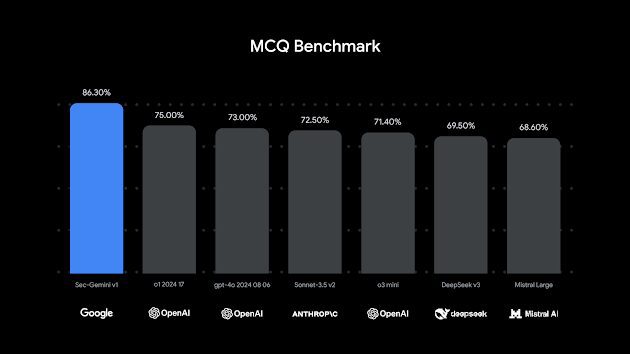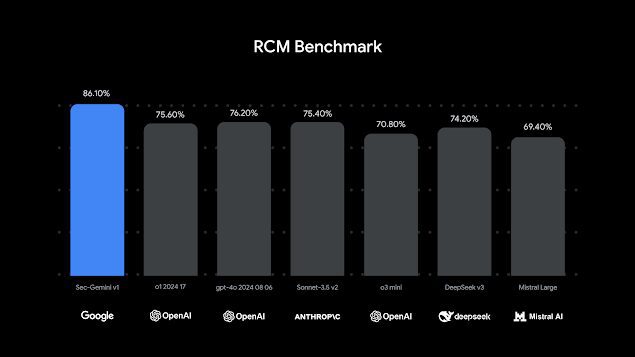Sec-Gemini v1
Sec-Gemini v1, a new experimental AI model designed to push the boundaries of cybersecurity AI.
As stated a year ago, attackers must effectively identify and take advantage of a single weakness, while defenders must contend with the difficult challenge of protecting against all cyberthreats. Systems security has become more challenging, time-consuming, and error-prone due to this basic asymmetry. Because AI-powered cybersecurity workflows are forcing more cybersecurity professionals than ever before, they may help tip the scales back in favor of the defenders.
Modern reasoning skills and in-depth knowledge of cybersecurity are essential for efficiently enabling SecOps processes. Sec-Gemini v1 does this by fusing near real-time cybersecurity expertise and tools with Gemini’s sophisticated capabilities. This combination enables it to perform better on important cybersecurity workflows, such as threat analysis, vulnerability impact understanding, and incident root cause analysis.
The adamant that the cybersecurity community must work together to successfully advance AI cybersecurity boundaries in order to significantly tip the scales in favor of the defenders. For this reason, they are making Sec-Gemini v1 openly accessible for research use to a limited number of institutions, experts, NGOs, and organizations.
Because of its sophisticated integration of Google Threat Intelligence (GTI), OSV, and other important data sources, Sec-Gemini v1 performs better than other models on important cybersecurity benchmarks. On CTI-MCQ, a top threat intelligence benchmark, Sec-Gemini v1 performs at least 11% better than other models (see figure 1). Additionally, it performs at least 10.5% better than other models on the CTI-Root Cause Mapping benchmark (see Figure 2):


An illustration of how thorough Sec-Gemini v1‘s responses to important cybersecurity queries are can be found below. First, because of its strong integration with Mandiant Threat intelligence data, Sec-Gemini v1 can identify Salt Typhoon as a threat actor (something that not all models can do) and gives a thorough description of that threat actor.
Next, when asked about the vulnerabilities in the Salt Typhoon description, Sec-Gemini v1 provides context for the vulnerabilities in relation to threat actors (using Mandiant data) in addition to vulnerability details (With its integration with OSV data, Google’s open-source vulnerabilities database). Analysts can more quickly comprehend the risk and threat profile linked to certain vulnerabilities using Sec-Gemini v1.
Important Concepts and Themes
The goal of Google’s new experimental AI model, Sec-Gemini v1, is to push the boundaries of cybersecurity AI.
Helping cybersecurity defenders overcome the basic asymmetry where they must fight against every danger while attackers only need to identify one is the main objective of Sec-Gemini v1. AI-powered cybersecurity workflows, according to Google, have the ability to tip the scales in favour of the defenders by greatly boosting cybersecurity experts’ efficacy.
Sec-Gemini v1 accomplishes its goals by fusing near real-time cybersecurity expertise and tools with Gemini’s sophisticated reasoning. It can perform better because to this integration in a number of crucial cybersecurity workflows, such as:
- Root cause analysis of incidents;
- Threat analysis;
- Knowledge of vulnerability impacts
Google highlights the value of cooperation among cybersecurity experts in order to advance this subject. Sec-Gemini v1 is being made publicly available for research use by a limited number of organisations, institutions, professionals, and non-governmental groups in order to support this.
The model’s sophisticated integration of Google Threat Intelligence (GTI), OSV (Google’s open-source vulnerabilities database), and other important data sources is responsible for its superior performance on important cybersecurity benchmarks. In particular, it has been demonstrated that Sec-Gemini v1 performs at least 11% better than other models on the CTI-MCQ benchmark, a top threat intelligence benchmark.
A minimum score of 10.5% on the CTI-Root Cause Mapping benchmark, which assesses an LLM’s comprehension of vulnerability descriptions, identification of underlying root causes, and categorisation of those issues using the CWE taxonomy


